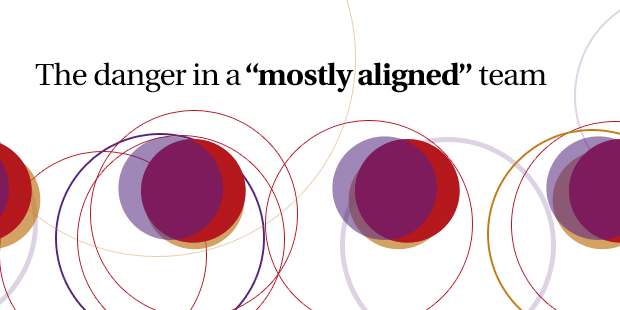
The Danger in a “Mostly Aligned” Team
My two worlds collided one recent weekend. I introduced my young daughters to the classic film, The Princess Bride. I also had just completed a number of interviews with executives and stakeholders of a client I’m working with on Leading Change in these remarkable times. These things may seem unrelated, but watch how this comes together.
My girls loved Billy Crystal as Miracle Max. The minute the credits ended, they began quoting him. “Girls, come down to dinner,” was met with, “Why don’t you give me a paper cut and rub some lemon juice in it?” My youngest daughter punctuated her kiss goodnight with, “Bye bye boys, have fun storming the castle!” When I asked the girls to retrieve a book for me, they responded with, “It will take a miracle!”
“It will take a miracle” — this is how many business leaders feel as they try to rally their organizations around a big opportunity. After the girls went to sleep, I started reviewing my interview notes from earlier in the week. During these interviews, we always ask about strategy, opportunities and challenges. We also ask how aligned the leadership team is around where they are going, how they want to get there and how quickly and boldly they are planning to move. As I read their responses, I kept hearing Miracle Max. The most common response for this client, as with many of our clients, was “mostly aligned.” Miracle Max had a great line about “mostly”: “Mostly dead is slightly alive.”
I believe executive alignment—really, any alignment—is binary: you either are or you are not. I think about the wheels on my car being “mostly aligned” and what that would feel like. Yet most leadership teams stop at “mostly aligned” and accept it as sufficient. They tend to forget that “mostly aligned” is amplified exponentially further down in the organization, creating more and more distance among an organization’s members. By the time you’ve reached the rank-and-file, the organization is only slightly alive.
One interview answer particularly caught my eye: “ We are aligned on the things we need to be aligned on. The other stuff … we don’t play in each others’ sandboxes.” We talked to the people who worked for this interviewee. They too, recognized this leaders’ attitude, which they translated as, “They do their best to not work together with others or have us coordinate our efforts.”
This may seem trivial, but here are the downstream and long-term effects of this lack of alignment:
- Inconsistent instructions based on different interpretations of a new strategy;
- Conflicting priorities across silos and departments;
- Performance metrics and expectations that reward silo performance and individual achievement over organization-wide results and customer satisfaction;
- Vastly different content, focus and messages from meetings.
So, what will it take for these executives to get from “mostly aligned” to aligned? It won’t take a miracle, or even a really big (though chocolate-covered) pill. It will demand the courage to create the time and space to have a conversation about what needs to change so they can accelerate their strategies toward success. Often executives will say they are too busy to make that kind of space. Later, they recognize the turbulence, lost opportunities and wasted energy they’ve caused, and how it has crippled their strategic efforts.
But with a little effort—no magic required—an organization can go from “slightly alive” to thriving.
Read more from Kotter International here.

Tags: Alignment, John Kotter, Ken Perlman, Vision Clarity












